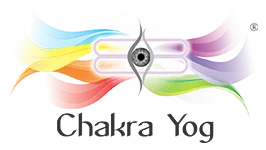Yoga Asanas for Sahasrara Chakra

The life force energy (known as “prana”) passes through the subtle body through a number of channels known as “nadis” in yoga. These nadis meet at areas of amplified energy known as “chakras.” Chakras are swirling vortexes of energy in the subtle body that correlate to specific glands along the spine and within the head. They are named after the Sanskrit word for “wheel.” When the nadis get blocked due to bad behaviors and old patterns, the chakras become stagnant. The life force becomes sluggish as a result, which may lead to reduced physical, mental, and emotional health. Yoga practice cleanses and revitalizes the nadis and chakras, allowing prana to flow freely again.
Yoga is an incredibly useful method for releasing prana, or life energy, when it becomes wedged. Through yoga poses (asanas) and breathing, yoga dissolves musty energy and allows new energy into our chakra system. As a means of rebalancing our chakras so that they work optimally we may practice yoga as it definitely helps to either activate a blocked chakra or discharge excess energy from a dysfunctional chakra, for example when a chakra becomes overactive.
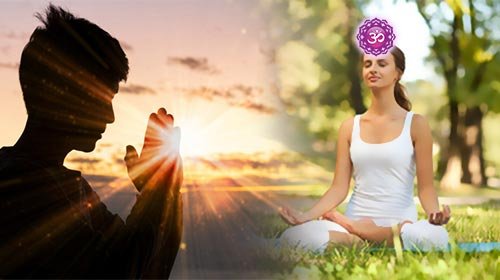
An effective way to bring to balance the Crown (Sahasrara) Chakra is to resort to yoga asanas practice on a regular basis, which stabilizes and balances your physical body’s energies from the Crown vortex. When Sahasrara chakra is balanced, you have great intuitive knowledge and are selflessly devoted to the well-being of others because you see others as a part of you rather than as something separate from you. You are aware of your spiritual self, and as a person, you are grounded and self-sufficient. Our habits and attitudes have changed dramatically. The ego no longer has control over the Self. Gratitude, compassion, and acceptance are examples of emotions that manifest as our true Self. A healthy Crown Chakra promotes spiritual understanding, peace, and mental clarity.
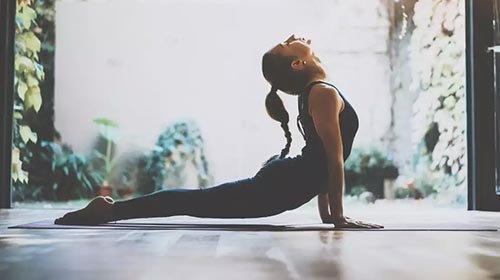
Yoga can be practiced at home, in natural environments or in a yoga studio. At the same time, each chakra is connected with different universal elements being Air, Earth, Water, Ether or Fire. While yoga asanas may be practiced with beneficial results in many distinct surroundings, it is recommended whenever is possible to do these in particular places related to the chakra’s element to enhance the whole experience and results. Silence is the key factor to set up a convenient ambiance for healing the Crown chakra. Meditation in calm places far away from the noises of the crowds of the cities and towns makes us to turn inwards and connect with our inner divinity in ourselves. This is particularly true for breathing techniques (kriyas) and meditation time. Nevertheless, in the case of rough yoga poses as headstand it is recommended to attend a professional yoga studio, at least until we learn well to manage these yoga asanas by ourselves.
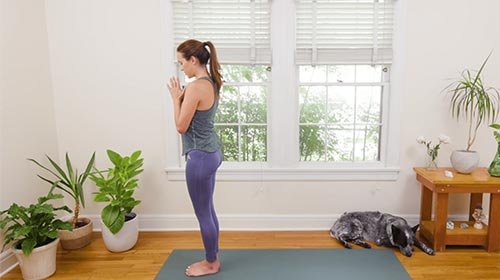
Creating a home yoga studio has several advantages and may take your yoga practice to a whole new and enhanced level. It helps you to immerse yourself in yoga so that it becomes a more important part of your everyday rather than something that is exclusively performed at a studio. Indeed, yoga experts and teachers acclaim contrary to popular belief to practice yoga at your own pace in your own place rather than in busy and distracting public yoga centers which tend to rush the practice in too active modes and with limited time and procedures. They reiterate that the practice of yoga should be paced at each person’s rhythm thus allowing a much better integration of the practice as it involves aspects like focus, absorption, breathing or meditation. Therefore, getting involved in public spaces with yoga experienced teachers is principally suggested mostly to get started with the right postures under their supervision at first, but more personal places and environments are more suitable for yoga practice for the healing and balancing of our energy centers (chakras) in the long-term.
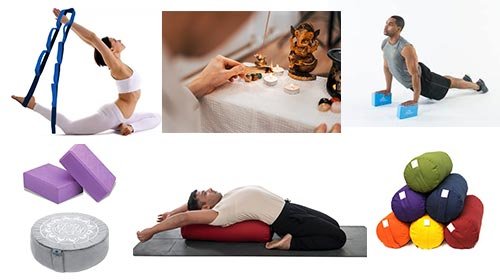
Even in the tiniest of areas, you can carve out a nook and corner for your home yoga studio. The first item you’ll need is a yoga mat, or if you can’t find one, a towel will do. It will protect you from slipping and sliding while you practice yoga.
Below are some other items you may need in your daily yoga practice:
- Yoga Bolsters are used to aid in relaxing, softening postures, and opening up the body. As an alternative, you may make an improvised bolster out of a pillow covered in a blanket. It forms an oval and may be used as a bolster to rest against.
- Yoga Blocks are used to aid in the practice of yoga by bringing the floor closer to you if you are unable to reach it in certain poses. If you don’t have access to yoga blocks, you may use thick books.
- Yoga Straps are used to assist yoga practitioners in achieving a greater range of motion and increased flexibility. Likewise, resistance bands may also be used as an alternative.
- Yoga blankets are great to have on hand since they can help you sit comfortably and relax in restorative positions. As an alternative to yoga-specific blankets, you may use blankets from your bed, throw blankets from your sofa, or towels.
- Yoga cushions and chairs aids in meditation and they are utilized to keep the body in a comfortable sitting posture. They tilt the pelvis, allowing you to sit erect and securely in meditation position. If they are not accessible, you may sit on any cushion from your home, such as one from your sofa or bed, while meditation.
- Altars and the things that decorate them are utilized to integrate the energy of your yoga practice into your surroundings. Deities’ sculptures and sacred symbols and pictures are often placed.
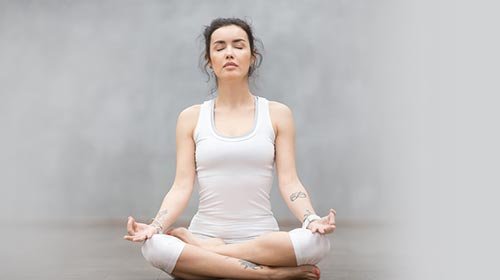
In order to tune up Sahasrara start with Kapalabhati pranayama. Close your eyes and take a comfortable seat. On each hand, bring your forefinger and thumb together. Inhale through your nose and exhale quickly through your nose, drawing your belly button back toward your spine. The inhalation is passive, while the exhalation is sharp and quick. You can go as fast or as slowly as you like. Set your intention for this practice and after done follow the next yoga sequence.
Sahasrara represents universal consciousness. It has an impact on brain functions such as intelligence, concentration, and memory. When activated spiritual growth is experienced along with infinite wisdom and higher consciousness. People gain a sense of unity, power, and self-knowledge by strengthening their connection to their spirit or soul. People with enlightened wisdom and spiritual power have a better understanding of the physical world around them. This can help one maintain a positive outlook on life and overcome obstacles in their daily lives.
Active Yoga poses for Sahasrara:
Headstand (Sirsasana)
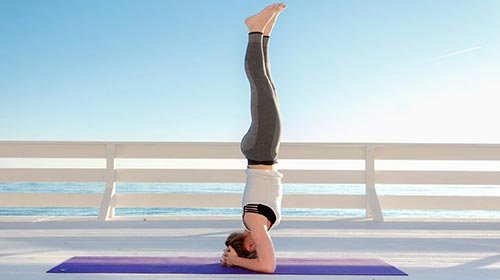
This position is critical for effective learning. It is said to be an excellent position for increasing the energy in the Crown Chakra. Because of the potential of neck damage, you should gradually go to this posture. In addition to finding an excellent instructor, you might try these suggestions. When you hold your posture properly, the power of your core muscles will generate a sense of buoyancy and solidity. Try to hold this position for as long as you can while keeping smooth and regular breathing. A conventional advice is five complete breaths, which you may gradually increase as the position becomes more comfortable and sustainable.
Shoulderstand (Sarvangasana)
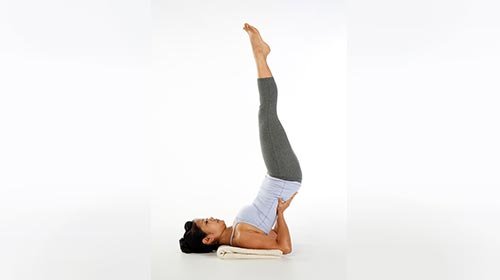
Lie on your back with your upper back supported by a thickly folded blanket. Because your head lies on the mat, the blanket terminates in the hollow of your neck. Legs are either extended or bowed at the knees. Your arms are adjacent to your body, palms down. Exhale by pressing your lower back into the floor, and inhale by lifting your legs up while pressing your arms and hands into the floor. Sweep your legs over your head, then curve your hips up and off the floor with that momentum. Roll onto your back, concentrating on your upper back and shoulders. For support, bend your elbows and rest your hands on your back. Extend your legs towards the ceiling. Draw your elbows in and move your hands up your back, towards the upper back, to assist elevate your spine off the floor. Draw your shoulder blades in and open your chest. Draw your thighs in slightly and retain the majority of your weight in your upper back and arms. Relax your face and neck, look at your chest, and direct your breathing to your belly. You may begin by holding this stance for 30 seconds and gradually increase the duration. At exit, drop your legs to a 45-degree angle towards the floor. Then, gently and carefully roll your spine back to the floor (knees bent if you like), ultimately putting your feet on the floor.
Rabbit Pose (Sasangasana)
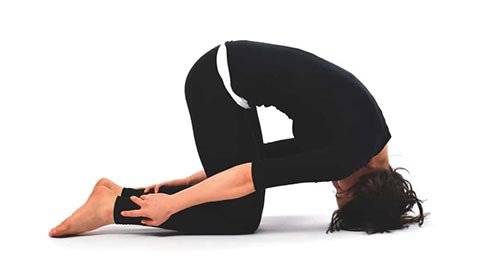
Rabbit Pose is a great approach to connect with the Sahasrara Chakra without having to undergo a full inversion. Bow forward from knees, bringing the top of your head toward the floor. (It is not required that it contact the floor.) By reaching back with your arms, cup your heels with your hands. Contract your abdomen tightly to elevate your low and mid-back, as well as your hips, off the ground. Maintain a modest profile. Remove your shoulders from your spine. If your head comes into contact with the ground, use a soft touch rather than forceful pressure. When your tummy is held so close to your thighs, notice how the sides and back of your body expand with each breath. After a few breaths, drop your hips into your heels, let go of your heels, and roll up through your spine to a sitting posture.
Half Lotus (Ardha Padmasana)
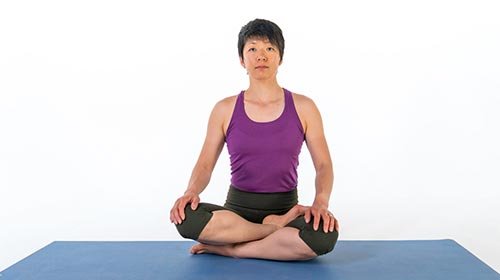
This crown chakra yoga stance opens the door to greater awareness. During this contemplative attitude, much change happens. The Lotus pose is the most prevalent meditation position. Sit on a mat or cushion to begin. This position will benefit by sitting on the ground outside. Put one foot on the opposing thigh and the other on the floor under the opposing thigh. Make sure both of your knees are on the floor to keep your spine balanced. You may also pray by holding your hands together. Stay in this comfortable pose for as long as you want.
King Dancer Pose (Natarajasana)
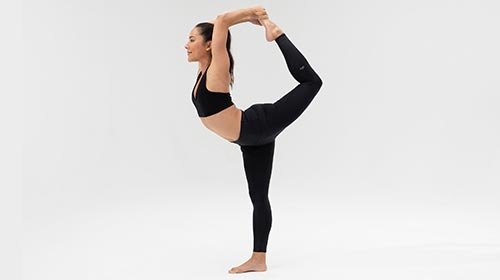
Begin in Mountain Pose (Tadasana), with your weight evenly distributed on both feet. Transfer your weight to your right foot. Bend your left knee such that your left foot is lifted off the floor. Throughout this position, keep your left knee aligned with your midline. With your left hand, grasp the instep of your left foot. Your thumb should be lying on the bottom of your foot and pointed toward your toes. Lift your right arm straight up towards the ceiling. Lift your left leg gently behind you as you move your body forward to compensate. Your left knee should stay in line with the rest of your body and not splay out to the side. Move your right arm forward to stabilize yourself. To elevate the leg higher and deepen the backbend, kick your left foot firmly into your left hand at this moment. You should be able to move your left toes. To avoid losing your equilibrium, keep your sight (Drishti) concentrated on something that does not move. Hold the posture for 5–10 breaths. Lower your left leg slowly to bring it back into line with your right. Rep the stance with the other leg.
Crocodile Pose (Makarasana)
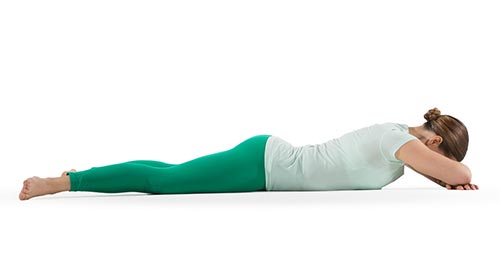
Crocodile is another apparently simple yet crucial posture. You should be able to relax your whole body while in Crocodile position, reducing stress and tension and clearing your mind. Relax your body more and more with each breath, focusing on the fundamental connectedness of your whole body.
Restorative Yoga poses for Sahasrara:
Restorative yoga poses are practiced always at the end of the yoga practice to provide rest to the body and self-assimilation of the yoga asanas previously done. They are all about slowing down and incorporating what has been done.
Corpse Pose (Savasana)
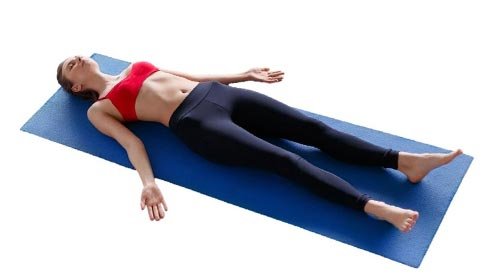
When you’re finished, fall back in Savasana and allow your body to relax as if you’re floating on top of water, drifting into a tranquil and pleasant repose.
Aside from the yoga positions outlined above, cultivating a deeper feeling of steadiness throughout your practice may take various forms. If visualizations have previously benefited you in your practice, consider imagining or wearing the color white, which is the color of the Crown (Sahasrara) Chakra. This vision may assist you in rekindle your inner flame revealing a stronger connection while practicing the above yoga asanas. Singing mantras and also using sound vibrations in the background is another excellent approach to connect with your Crown (Sahasrara) Chakra while doing yoga, although Silence is most effective.


